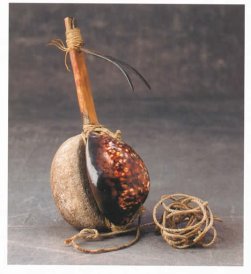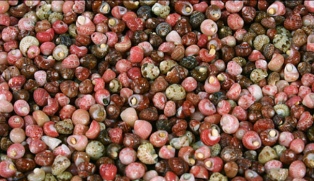1. n. General name for marine and land shells; beads, snail (Biblical). Lei pūpū ō Niʻihau, shell beads of Niʻihau. See lei pūpū. Mehe pūpū lā e heheʻe ana (Hal. 58.8), like the snail that dissolves [into slime]. (PCP puupuu.)
2. n. Any circular motif, as in tapa. Kōnane pūpū, checkerboard pattern [with rounded pits on each square, as on tapa].
3. nvt. Relish, appetizer, canapé, hors dʻoeuvre; formerly, the fish, chicken, or banana served with kava; to eat a pūpū. Cf. pū 9. Ā pūpū i ka ʻanae (For. 5:491), and mullet as appetizer. (PPN puupuu.)
4. nvi. Bunch, tuft, bundle, as of grass; bouquet; to be bundled up; three or four ʻuo tied together, to be used for featherwork. Cf. pūpū weuweu. Pūpū pili, bundle of pili grass. Pūpū husopa (Puk. 12.22), bunch of hyssop. hoʻo.pū.pū To arrange in bunches. (PPN puupuu.)
5. nvt. To draw or gather together; to draw tight, as a fishing net. Cf. pūpū lauoho, pūpū weuweu. Pūpū wahi kūʻōʻō ka mahi ʻai o uka; ola nō ia kini he mahi ʻai na ka ʻōiwi, the upland farmer gathers the small injured sweet potatoes; the multitudes find life, when the farmer farms for himself [though the potatoes may be small, the independent farmer supplies his kin].
Today’s He Momi reflects our cherished pūpū or shells, a number of which are found in our ocean waters or in our mountains! Yes. mountains.
Our most highly prized pūpū are the Niʻihau shells, known as pūpū o Niʻihau, shells of Niʻihau (although you can find them on Kauaʻi shores). Each pūpū o Niʻihau has a distinct name: pūpū laiki (rice shell, named because its shape and color resembles a grain of rice) and pūpū Kahelelani, named for a chief famous on that island.
There is the pūpū kani oe and the kāhuli or the land and tress snails, many species which are extinct or endangered. These pūpū (there were/are some 800 species), like many other endemic plants and animals here, carefully evolved over time as a unique and precious native of specific landscapes and locations. One unique feature to the tree snail, unlike most mollusks which produce eggs, is that it is born alive, complete with its own shell. Top speed of a tree snail is about three inches a minute.
Back to the ocean and one of my favorite pūpū, the leho or leholeho, the cowry shell. This pūpū was prized by the heʻe (octopus) and thus, the heʻe fisherman. Hawaiians would make a lure, using the pūpū leho, a favorite food of the heʻe, with a hook and line.
 Of course, this Super Bowl Sunday, you are probably more concerned with #3 above. Pūpū are also appetizers. One big mistake everyone makes is putting an s on the end of the word: pupus. Big no no. You don’t need to AND you shouldn’t. Do not pluralize any Hawaiian word with an s. Trust me. When using the word pūpū people will know whether it is plural or singular just by the context.
Of course, this Super Bowl Sunday, you are probably more concerned with #3 above. Pūpū are also appetizers. One big mistake everyone makes is putting an s on the end of the word: pupus. Big no no. You don’t need to AND you shouldn’t. Do not pluralize any Hawaiian word with an s. Trust me. When using the word pūpū people will know whether it is plural or singular just by the context.

Kahelelani


Looking for enough land snails How to make a Hawaiian Lei…
Does anyone on your staff make leis from shells?
If so, please let us know